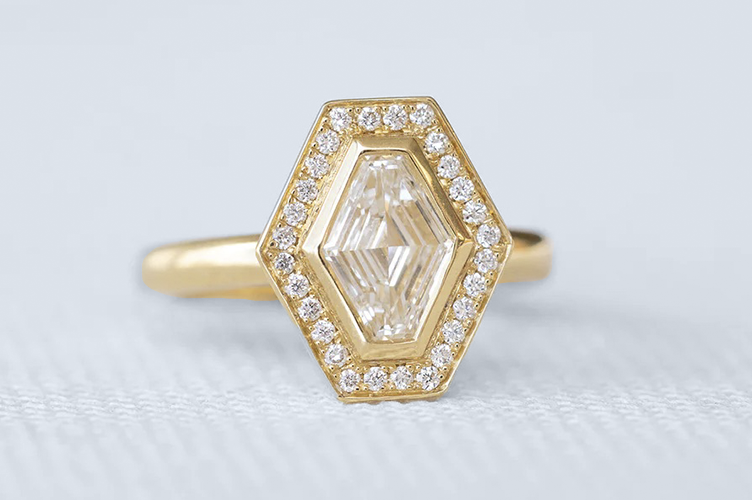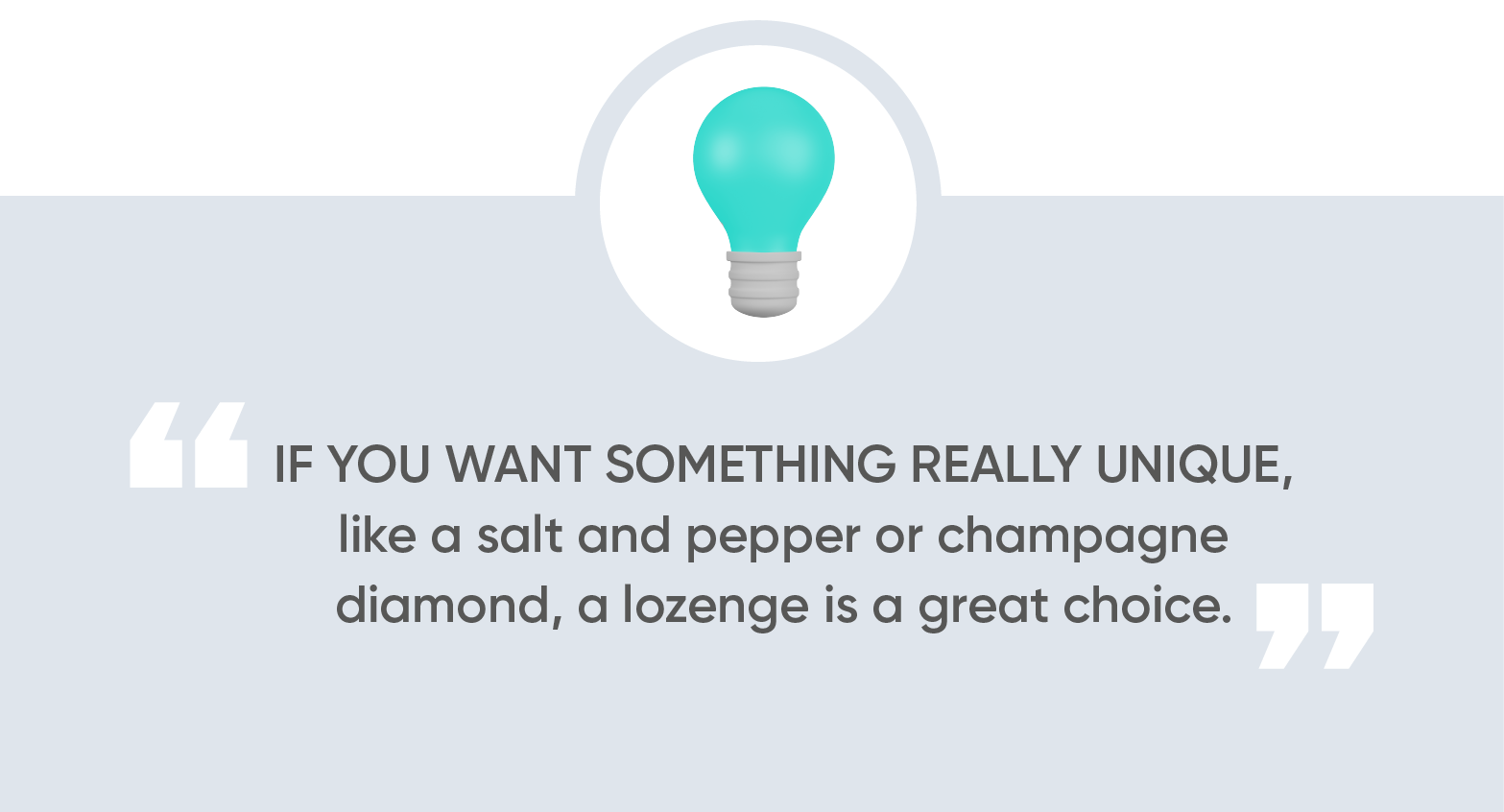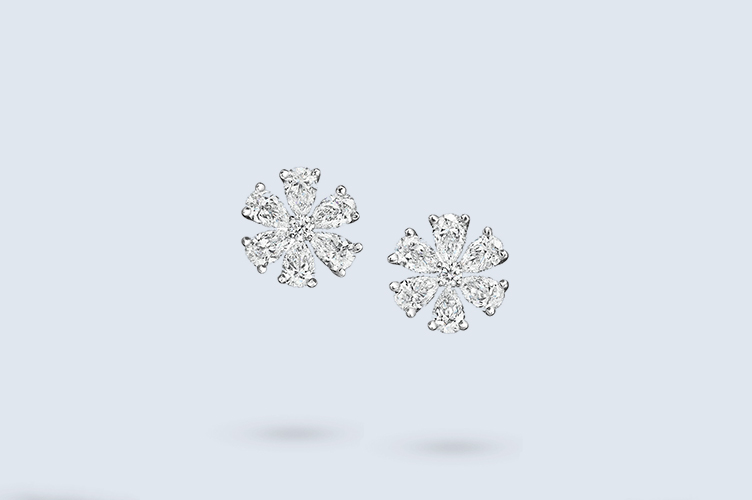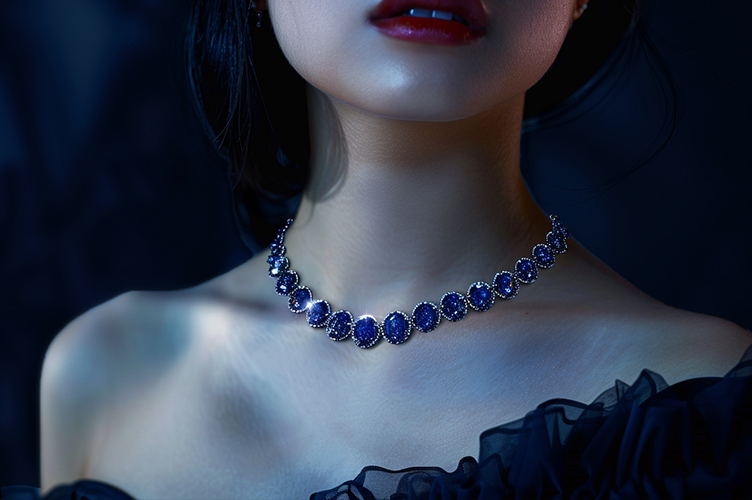Choosing the perfect engagement ring can be hard work. Learning the common diamond cuts takes time, and then there’s exploring all the more unique diamond shapes, so you can be sure you’re picking the best fit for your soon-to-be fiance.
If you’re looking for a one-of-a-kind design, the lozenge cut diamond is worth checking out. Here’s what you need to know.
What You Will Learn
What are Lozenge Cut Diamonds?
Lozenge cut diamonds boast a rectangular shape with rounded corners. They resemble a stretched-out diamond or rhombus. Their elongated silhouette offers a sleek, modern vibe, making them a neat alternative to other, more traditional diamond cuts.
To create a lozenge cut, skilled diamond cutters shape a rough diamond with precise cuts and facets, to enhance the stone’s brilliance and fire while accentuating its unique geometric charm. The resulting diamond is a fusion of brilliance and geometric beauty.
Why Choose a Lozenge Diamond
There are a few reasons why you might choose a lozenge diamond for your engagement ring.
- Unconventional Beauty: Lozenge cut diamonds offer a refreshing departure from the more common round or emerald cut diamond. Their distinctive shape and elongated profile will always turn heads.
- Brilliance and Sparkle: Though not as sparkly as a round brilliant cut, lozenge diamonds do feature shiny facets that reflect light and show off their depth.
- Versatile Design Possibilities: The elongated shape of a lozenge cut diamond lends itself to all types of engagement rings. Its clean lines and proportions make it an excellent choice for both solitaire and multi-stone designs.
Choose the Right Lozenge Cut Diamond Ring
When selecting a lozenge cut diamond for your engagement ring, consider these factors:
- Proportions: Look for a well-proportioned lozenge cut diamond that balances its length and width, ensuring pleasing visual appeal.
- Clarity: Opt for the best diamond clarity that your budget can afford. While some minor inclusions are fine, choose a diamond with good overall clarity for that clear, deep appearance.Navigating the Different Types of Diamond Clarity
- Color: Thanks to their large table, lozenge cut diamonds tend to showcase color more than other cuts. This can be good or bad. If you want a clear, crisp white diamond, you’ll need to pay more for a higher color grade. If you want something really unique, like a salt and pepper or champagne diamond, a lozenge is a great choice.
Consider a Custom Piece
Want your engagement ring to truly be one-of-a-kind? Since lozenge diamonds are already rare, choosing one is a great opportunity to create a customized ring.
Find a jeweler you trust, and let them help you bring your vision to life. From selecting the perfect lozenge diamond to choosing intricate details and accent stones, you can customize all the product details.
Designing a ring with a reputable jeweler is also a great way to ensure your ring is made with quality craftsmanship in mind, as well as the best materials. At the end of production time, you’ll have the opportunity to review all specifications and make sure it’s perfect, before taking your new ring home.
Crafting the Perfect, Custom Lozenge Cut Diamond Ring
If you do decide to create a custom piece using a lozenge cut diamond, here are our top tips to take with you to the jeweler:
1. Embrace the Uniqueness
A lozenge cut diamond already stands out with its unconventional shape. Incorporate design elements that accentuate this further.
Consider pairing the lozenge cut center diamond with side stones, such as trapezoid or baguette cuts, to enhance its visual impact. Play with contrasting yellow and white gold, or intricate detailing on the band, to create a truly special ring.
2. Prioritize Proportions and Balance
Work with your jeweler to find the perfect balance between the diamond’s size and the overall proportions of the engagement ring. It’s important to strike a harmonious balance between the center stone and any accompanying accent stones.
Of course, you’ll also want to utilize the ring sizers at the jewelry store and make sure you know your (or your partner’s) true ring size and how that size will play against the diamond’s proportions.
3. Pay Attention to Setting Choices
Consider settings that offer both security and visual appeal. Prong settings ensure the diamond is held firmly in place, while allowing maximum light exposure. Bezel settings likewise provide excellent protection for the diamond’s corners, making these settings a suitable option for those seeking added durability.
Explore different setting styles, such as solitaire, halo, or three-stone, to find the one that best complements your diamond’s unique characteristics.
Don’t Forget Insurance
Whether it’s a unique and modern lozenge cut, or a classic and traditional round cut, every diamond needs to be fully insured. Loss and theft happen even to those of us with the best intentions, and homeowners and renters policies don’t offer the coverage necessary to protect fine jewelry.
Your diamonds will always be safest with specialized jewelry insurance. BriteCo makes obtaining and maintaining your jewelry insurance fast, easy, and affordable.
Get a free quote today and keep your diamond jewelry safe, with coverage you don’t even have to think about.
Also Check:
Portrait Cut Diamond | BriteCo Jewelry Insurance
Hexagon Cut Diamond | BriteCo Jewelry Insurance
Are Rose Cut Diamonds Good for an Engagement Ring?
Heart Cut Diamonds: Love in Every Facet











